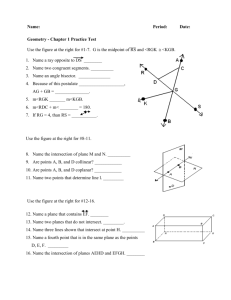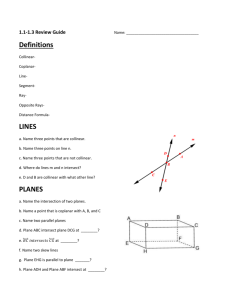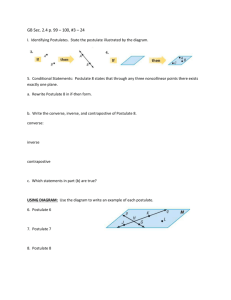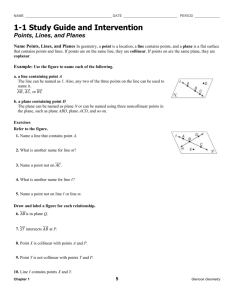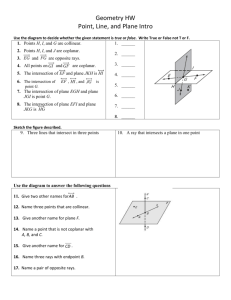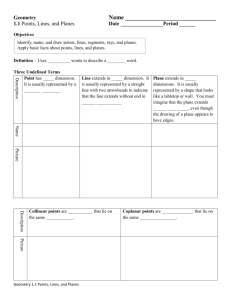PP Section 1.1
advertisement
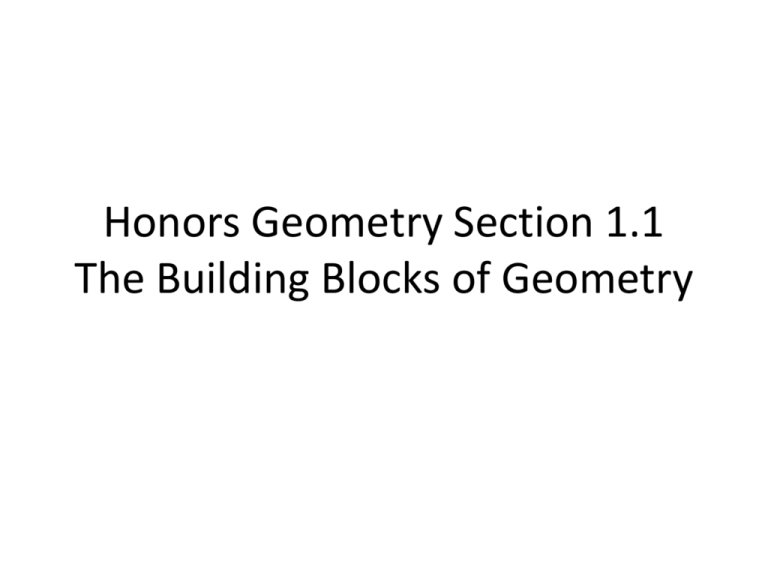
Honors Geometry Section 1.1 The Building Blocks of Geometry Webster’s New World Dictionary, Third College Edition, gives the following definitions. turn: to rotate or revolve rotate: to turn or cause to turn revolve: to turn In our study of geometry, in order to avoid circular definitions, we will leave 3 terms undefined. point: Usually described as a dot but actually has no size. Named by a capital letter. Note: When you see a capital letter in a figure, it represents a point even if the point is not drawn. line: A set of points that continues on without end in two opposite directions. Named by a single lower case letter ( line m or m)or any two points on the line ( AB or BA ). plane: A set of points that extends without end in 2 dimensions. Named by a single capital letter placed in a corner ( plane M or M ) or by 3 points that do not all lie in the same line ( plane BCA ) In the description of a plane, we talked about 3 points not on the same line. Three points not on the noncollinear same line are called ___________. Points are collinear if they lie on the same line. Points are coplanar if they lie on the same plane. Noncoplanar? Just as undefined terms are the starting point for the vocabulary of geometry, postulates are going to be the starting point for the rules of geometry. A postulate or axiom is a statement that is accepted as true without proof. Postulate 1.1.4: The intersection of two lines is a point. Postulate 1.1.5: The intersection of two planes is a line. What important idea about planes is indicated by this postulate? planes continue on without end Postulate 1.1.6: Through any two points there is exactly one line. What important idea about lines is indicated by this postulate? lines must be straight Postulate 1.1.7: Through any three noncollinear points there is exactly one plane. What if the three points were collinear? infinitely many planes contain collinear points Postulate 1.1.8: If two points lie in a plane then the line containing them is in the plane. What important idea about planes is indicated by this postulate? planes must be flat While it certainly may seem as though these postulates are not saying anything of any real importance, nothing could be farther from the truth. These postulates are in fact the basis of Euclidean geometry. For Euclid, planes are a flat surface like the floor and lines are straight like your pen or pencil. But what if we thought of a plane as being the surface of a sphere (i.e. the globe) and lines as being great circles on the sphere (i.e. the equator or any lines of longitude). Such thinking results in a whole different type of geometry called spherical geometry. Example: Determine if the given set of points are collinear, coplanar, both or neither. 1) B, D both 2) E, F, A coplanar 3) B, C, D, E neither 4) E, F, G, A coplanar A line segment or segment is part of a line that begins at one point and ends at a second. Segments are named by their two endpoints ( AB or BA ). A ray is a part of a line that begins at one point and extends infinitely in one direction. Rays are named by their endpoint and another point on the ray (________). BA or BC The intersection (symbol: ______) of two (or more) geometric figures is the set of points that are in both figures at the same time. The union (symbol: ______) of two (or more) geometric figures is the set of points that are in one figure or the other or both. Example: Determine the following intersections and unions based on the figure below. DI Example: Determine the following intersections and unions based on the figure below. DI FH Example: Determine the following intersections and unions based on the figure below. DI FH DI Example: Determine the following intersections and unions based on the figure below. F Example: Determine the following intersections and unions based on the figure below. F GE Example: Determine the following intersections and unions based on the figure below. F GE Example: Assume the two given figures are not the same figure and that the two figures have at least one point in their intersection. Determine all possible intersections of the two figures. a. two lines A point Example: Assume the two given figures are not the same figure and that the two figures have at least one point in their intersection. Determine all possible intersections of the two figures. b. a plane and a line A point A line Example: Assume the two given figures are not the same figure and that the two figures have at least one point in their intersection. Determine all possible intersections of the two figures. c. Two rays A point A line Segment A ray


